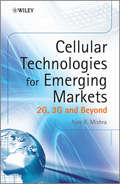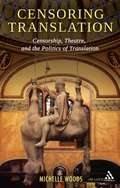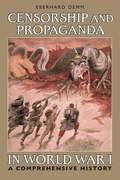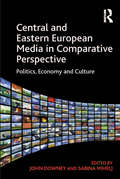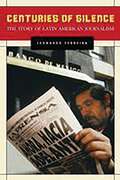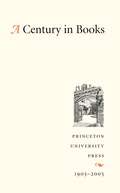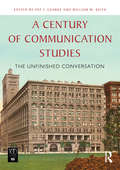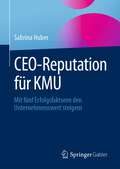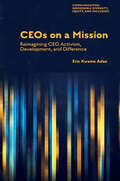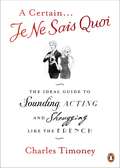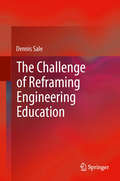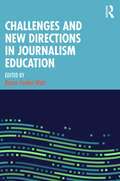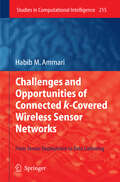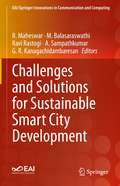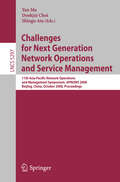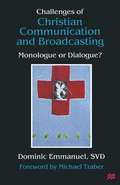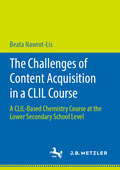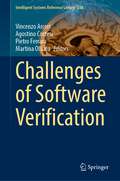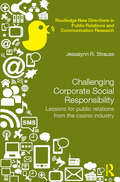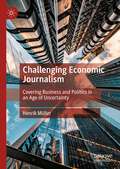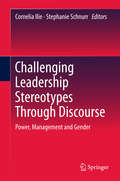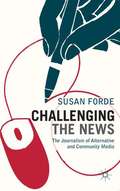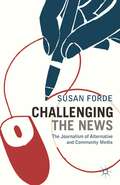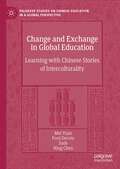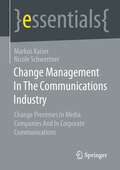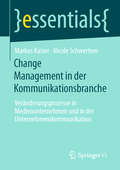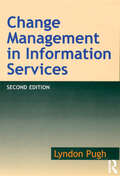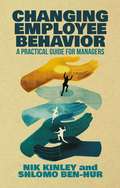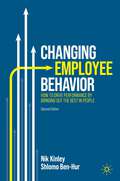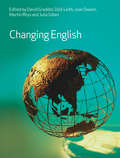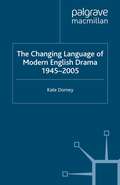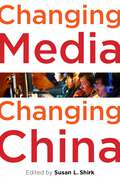- Table View
- List View
Cellular Radio: Principles and Design
by R.C.V. MacarioThis second edition reflects the changes that have taken place in this fast developing area in recent years.By focusing on the desirable features of cellular radiotelephones, the book describes the basic functioning of present day cellular radio services in all parts of the world - from the USA to Scandinavia, the UK to Japan. This approach is especially adopted for the description of digital systems, where common fundamental features and requirements are carefully explained. Many new illustrations and tables are added to clarify the explanations.
Cellular Technologies for Emerging Markets: 2G, 3G and Beyond
by Ajay R. MishraIn this book, the author addresses technologies that are being used in emerging cellular markets. These include GSM/EGPRS and CDMA which are being deployed at a rapid pace, while technologies such as UMTS (3G)/ HSPA (3.5G) which have started to find a place in these high growth markets, are also considered. The book examines other technologies including LTE (3.9G) which have already moved out of research labs into the commercial world. 2G-CDMA is widely used, while further developments, e.g. CDMA2000 are also finding acceptance in the commercial arena. IMS/Convergence is increasingly popular all over the world; UMA, which is deployed mostly in North America; and DVB which is gaining worldwide popularity, especially in South Asia, are all reviewed. Each chapter discusses a different technology and is structured into three parts. The technology is examined at an overview level, first explaining what the technology is and then considering the technical features of the technology. The chapter concludes by looking at the planning/implementation aspects of the technology. Key Features: Useful for all cellular industry professionals as provides an overview of the currently deployed technologies in mass scale, and the forthcoming technologies that are expected to make an impact in the future, such as 4th Generation Cellular Networks. One of the first books on the market to encompass all the major cellular technologies, as well as considering the design and implementation perspective. Wireless Technology will play a key role in uplifting the economies of the Emerging countries globally. Ashok Chandra, Wireless Advisor to Govt. of India
Cellular Technologies for Emerging Markets: 2G, 3G and Beyond
by Ajay R. MishraIn this book, the author addresses technologies that are being used in emerging cellular markets. These include GSM/EGPRS and CDMA which are being deployed at a rapid pace, while technologies such as UMTS (3G)/ HSPA (3.5G) which have started to find a place in these high growth markets, are also considered. The book examines other technologies including LTE (3.9G) which have already moved out of research labs into the commercial world. 2G-CDMA is widely used, while further developments, e.g. CDMA2000 are also finding acceptance in the commercial arena. IMS/Convergence is increasingly popular all over the world; UMA, which is deployed mostly in North America; and DVB which is gaining worldwide popularity, especially in South Asia, are all reviewed. Each chapter discusses a different technology and is structured into three parts. The technology is examined at an overview level, first explaining what the technology is and then considering the technical features of the technology. The chapter concludes by looking at the planning/implementation aspects of the technology. Key Features: Useful for all cellular industry professionals as provides an overview of the currently deployed technologies in mass scale, and the forthcoming technologies that are expected to make an impact in the future, such as 4th Generation Cellular Networks. One of the first books on the market to encompass all the major cellular technologies, as well as considering the design and implementation perspective. Wireless Technology will play a key role in uplifting the economies of the Emerging countries globally. Ashok Chandra, Wireless Advisor to Govt. of India
Cellular Vehicle-to-Everything (Wireless Networks)
by Shanzhi Chen Jinling Hu Li Zhao Rui Zhao Jiayi Fang Yan Shi Hui XuThis book focuses on cellular Vehicle-to-Everything (C-V2X), currently the most promising wireless communication technology for Vehicle-to-Vehicle (V2V), Vehicle-to-Infrastructure (V2I), Vehicle-to-Pedestrian (V2P), Vehicle-to-Network (V2N) and Vehicle-to-Cloud (V2C) communications. Because of its low latency and high reliability, C-V2X has become an essential enabling technology for Intelligent Transportation Systems (ITSs) and autonomous driving. This book begins by introducing readers to the research background and status quo of global development. Then, after analyzing the performance requirements of various V2X applications, the system architecture and technical standards are presented. The two evolving stages of C-V2X, i.e., LTE-V2X and NR-V2X, are introduced in detail. In addition, related technologies such as mobile edge computing, network slicing and high-precision positioning, C-V2X security, C-V2X spectrum requirements and planning, and industrial development and applications are introduced. In closing, the book discusses future applications of and technical challenges for C-V2X. This book is the first monograph dedicated to C-V2X, offering experts, researchers and engineers from the areas of IT/CT, intelligent transportation, intelligent and connected vehicles (ICVs) an in-depth understanding of C-V2X technology and standards, while also outlining related interdisciplinary research. The book can also be used as a reference resource for both undergraduate and graduate studies.
Censoring Translation: Censorship, Theatre, and the Politics of Translation
by Michelle WoodsA play is written, faces censorship and is banned in its native country. There is strong international interest; the play is translated into English, it is adapted, and it is not performed. Censoring Translation questions the role of textual translation practices in shaping the circulation and reception of foreign censored theatre. It examines three forms of censorship in relation to translation: ideological censorship; gender censorship; and market censorship. This examination of censorship is informed by extensive archival evidence from the previously unseen archives of Václav Havel's main theatre translator, Vera Blackwell, which includes drafts of playscripts, legal negotiations, reviews, interviews, notes and previously unseen correspondence over thirty years with Havel and central figures of the theatre world, such as Kenneth Tynan, Martin Esslin, and Tom Stoppard. Michelle Woods uses this previously unresearched archive to explore broader questions on censorship, asking why texts are translated at a given time, who translates them, how their identity may affect the translation, and how the constituents of success in a target culture may involve elements of censorship.
Censoring Translation: Censorship, Theatre, and the Politics of Translation
by Michelle WoodsA play is written, faces censorship and is banned in its native country. There is strong international interest; the play is translated into English, it is adapted, and it is not performed. Censoring Translation questions the role of textual translation practices in shaping the circulation and reception of foreign censored theatre. It examines three forms of censorship in relation to translation: ideological censorship; gender censorship; and market censorship. This examination of censorship is informed by extensive archival evidence from the previously unseen archives of Václav Havel's main theatre translator, Vera Blackwell, which includes drafts of playscripts, legal negotiations, reviews, interviews, notes and previously unseen correspondence over thirty years with Havel and central figures of the theatre world, such as Kenneth Tynan, Martin Esslin, and Tom Stoppard. Michelle Woods uses this previously unresearched archive to explore broader questions on censorship, asking why texts are translated at a given time, who translates them, how their identity may affect the translation, and how the constituents of success in a target culture may involve elements of censorship.
Censorship and Propaganda in World War I: A Comprehensive History (International Library of Twentieth Century History)
by Eberhard DemmThis book demonstrates how people were kept ignorant by censorship and indoctrinated by propaganda. Censorship suppressed all information that criticized the army and government, that might trouble the population or weaken its morale. Propaganda at home emphasized the superiority of the fatherland, explained setbacks by blaming scapegoats, vilified and ridiculed the enemy, warned of the disastrous consequences of defeat and extolled duty and sacrifice. The propaganda message also infiltrated entertainment and the visual arts. Abroad it aimed to demoralize enemy troops and stir up unrest among national minorities and other marginalized groups. The many illustrations and organograms provide a clear visual demonstration of Demm's argument.
Censorship and Propaganda in World War I: A Comprehensive History (International Library of Twentieth Century History)
by Eberhard DemmThis book demonstrates how people were kept ignorant by censorship and indoctrinated by propaganda. Censorship suppressed all information that criticized the army and government, that might trouble the population or weaken its morale. Propaganda at home emphasized the superiority of the fatherland, explained setbacks by blaming scapegoats, vilified and ridiculed the enemy, warned of the disastrous consequences of defeat and extolled duty and sacrifice. The propaganda message also infiltrated entertainment and the visual arts. Abroad it aimed to demoralize enemy troops and stir up unrest among national minorities and other marginalized groups. The many illustrations and organograms provide a clear visual demonstration of Demm's argument.
Central and Eastern European Media in Comparative Perspective: Politics, Economy and Culture
by Sabina MiheljAppearing more than twenty years after the revolutions in Central and Eastern Europe, this book could not have come at a more appropriate time; a time to take stock not only of the changes but also the continuities in media systems of the region since 1989. To what extent are media institutions still controlled by political forces? To what extent are media markets operating in Central and Eastern Europe? Do media systems in Central and Eastern Europe resemble media systems in other parts of Europe? The answers to these questions are not the same for each country in the region. Their experience is not homogeneous. An international line up of distinguished experts and emerging scholars methodically examine the different economic, political, cultural, and transnational factors affecting developments in media systems across Central and Eastern Europe. Whereas earlier works in the media system tradition have, in the main, adopted the political framework of comparative politics, the authors argue that media systems are also cultural and economic institutions and there are other critical variables that might explain certain outcomes better. Topics discussed range from political economy to gender inequality to the study of ethno-cultural diversity. This unmatched volume gives you the unique opportunity to study the growing field of comparative media analysis across Eastern and Western Europe. A valuable resource that goes beyond the field of media and cultural analysis which media scholars as well as to area specialists should not go without!
Central and Eastern European Media in Comparative Perspective: Politics, Economy and Culture
by Sabina MiheljAppearing more than twenty years after the revolutions in Central and Eastern Europe, this book could not have come at a more appropriate time; a time to take stock not only of the changes but also the continuities in media systems of the region since 1989. To what extent are media institutions still controlled by political forces? To what extent are media markets operating in Central and Eastern Europe? Do media systems in Central and Eastern Europe resemble media systems in other parts of Europe? The answers to these questions are not the same for each country in the region. Their experience is not homogeneous. An international line up of distinguished experts and emerging scholars methodically examine the different economic, political, cultural, and transnational factors affecting developments in media systems across Central and Eastern Europe. Whereas earlier works in the media system tradition have, in the main, adopted the political framework of comparative politics, the authors argue that media systems are also cultural and economic institutions and there are other critical variables that might explain certain outcomes better. Topics discussed range from political economy to gender inequality to the study of ethno-cultural diversity. This unmatched volume gives you the unique opportunity to study the growing field of comparative media analysis across Eastern and Western Europe. A valuable resource that goes beyond the field of media and cultural analysis which media scholars as well as to area specialists should not go without!
Central Processing Unit (CPU) (large print)
by RnibThis flowchart diagram shows the features of a computer central processing unit with input, output and backing store. The CPU, shown by a textured rectangle, is in the centre of the page. Inside this are three unfilled rectangles representing, from the top to bottom, the control unit, the arithmetic and logic unit, and the immediate access store. Linked by arrows to the CPU are three rectangular boxes. Input is to the left, output to the right and backing store at the bottom of the page.
Central Processing Unit (CPU) (UEB contracted)
by RnibThis flowchart diagram shows the features of a computer central processing unit with input, output and backing store. The CPU, shown by a textured rectangle, is in the centre of the page. Inside this are three unfilled rectangles representing, from the top to bottom, the control unit, the arithmetic and logic unit, and the immediate access store. Linked by arrows to the CPU are three rectangular boxes. Input is to the left, output to the right and backing store at the bottom of the page.
Central Processing Unit (CPU) (UEB uncontracted)
by RnibThis flowchart diagram shows the features of a computer central processing unit with input, output and backing store. The CPU, shown by a textured rectangle, is in the centre of the page. Inside this are three unfilled rectangles representing, from the top to bottom, the control unit, the arithmetic and logic unit, and the immediate access store. Linked by arrows to the CPU are three rectangular boxes. Input is to the left, output to the right and backing store at the bottom of the page.
The Centre
by Ayesha Manazir Siddiqi'Absolutely stunning . . .thrilling and unique' - GILLIAN FLYNN'Creepy, provocative and wildly entertaining' - EMMA STONEX'A banger!' - CHELSEA G SUMMERSWelcome to The Centre. You'll never be the same . . . Anisa Ellahi spends her days writing subtitles for Bollywood films in her London flat, all the while longing to be a translator of ‘great works of literature’. Her boyfriend Adam’s extraordinary aptitude for languages only makes her feel worse, but when Adam learns to speak Urdu practically overnight, Anisa forces him to reveal his secret.Adam tells Anisa about the Centre, an elite, invite-only programme that guarantees total fluency in any language in just ten days. Sceptical but intrigued, Anisa enrols. Stripped of her belongings and contact with the outside world, she undergoes the Centre’s strange and rigorous processes. But as she enmeshes herself further within the organization, seduced by all that it’s made possible, she soon realizes the disturbing, hidden cost of its services.By turns dark, funny and surreal, The Centre takes the reader on a journey through Karachi, London and New Delhi, interrogating the sticky politics of language, translation and appropriation with biting specificity, and ultimately asking: what price would you be willing to pay for success?A remarkable debut from Ayesha Manazir Siddiqi, announcing the arrival of an extraordinary new talent.
Centuries of Silence: The Story of Latin American Journalism (Non-ser.)
by Leonardo FerreiraThe history of Latin American journalism is ultimately the story of a people who have been silenced over the centuries, primarily Native Americans, women, peasants, and the urban poor. This book seeks to correct the record propounded by most English-language surveys of Latin American journalism, which tend to neglect pre-Columbian forms of reporting, the ways in which technology has been used as a tool of colonization, and the Latin American conceptual foundations of a free press.Challenging the conventional notion of a free marketplace of ideas in a region plagued with serious problems of poverty, violence, propaganda, political intolerance, poor ethics, journalism education deficiencies, and media concentration in the hands of an elite, Ferreira debunks the myth of a free press in Latin America. The diffusion of colonial presses in the New World resulted in the imposition of a structural censorship with elements that remain to this day. They include ethnic and gender discrimination, technological elitism, state and religious authoritarianism, and ideological controls. Impoverished, afraid of crime and violence, and without access to an effective democracy, ordinary Latin Americans still live silenced by ruling actors that include a dominant and concentrated media. Thus, not only is the press not free in Latin America, but it is also itself an instrument of oppression.
A Century in Books: Princeton University Press 1905-2005
by Princeton University Press StaffIt all began atop a drugstore in Princeton, New Jersey, in November 1905. From its modest beginnings, Princeton University Press was to become one of the world's most important scholarly publishers, embracing a wealth of disciplines that have enriched our cultural, academic, and scientific landscape.Both as a tribute to our authors and to celebrate our centenary, Princeton University Press here presents A Century in Books. This beautifully designed volume highlights 100 of the nearly 8,000 books we have published. Necessarily winnowed from a much larger list, these books best typify what has been most lasting, most defining, and most distinctive about our publishing history--from Einstein's The Meaning of Relativity (1922) to the numerous mathematical and other works that marked the Press's watershed decade of the 1940s, including von Neumann and Morgenstern's Theory of Games and Economic Behavior; from milestones of literary criticism by Erich Auerbach and Northop Frye to George Kennan's Pulitzer Prize-winning book on Soviet-American relations; from Milton Friedman and Anna Jacobson Schwartz's A Monetary History of the United States, 1867-1960 to more recent landmarks such as L. Luca Cavalli-Sforza, Paolo Menozzi, and Alberto Piazza's The History and Geography of Human Genes and Robert Shiller's Irrational Exuberance.In addition to succinct descriptions of the 100 titles and a short introduction on the history of the Press, the book features five essays by prominent scholars and writers: Michael Wood discusses the impact on Princeton University Press of intellectuals who fled Nazi Germany and authored many influential books. Anthony Grafton recounts our rich publishing tradition in history, politics, and culture. Sylvia Nasar traces our evolution into a leading voice in economics publishing. Daniel Kevles reflects on Einstein, a figure of special importance to Princeton. And Lord Robert May writes on our long-standing tradition of publishing in mathematics and science.A Century in Books is more than a celebration of 100 years of publishing at Princeton University Press--it is a treasure trove of 100 years of books that have added to the richness of twentieth-century intellectual life.
A Century of Communication Studies: The Unfinished Conversation
by Pat J. Gehrke William M. KeithThis volume chronicles the development of communication studies as a discipline, providing a history of the field and identifying opportunities for future growth. Editors Pat J. Gehrke and William M. Keith have assembled an exceptional list of communication scholars who, in the thirteen chapters contained in this book, cover the breadth and depth of the field. Organized around themes and concepts that have enduring historical significance and wide appeal across numerous subfields of communication, A Century of Communication Studies bridges research and pedagogy, addressing themes that connect classroom practice and publication. Published in the 100th anniversary year of the National Communication Association, this collection highlights the evolution of communication studies and will serve future generations of scholars as a window into not only our past but also the field’s collective possibilities.
A Century of Communication Studies: The Unfinished Conversation
by Pat J. Gehrke William M. KeithThis volume chronicles the development of communication studies as a discipline, providing a history of the field and identifying opportunities for future growth. Editors Pat J. Gehrke and William M. Keith have assembled an exceptional list of communication scholars who, in the thirteen chapters contained in this book, cover the breadth and depth of the field. Organized around themes and concepts that have enduring historical significance and wide appeal across numerous subfields of communication, A Century of Communication Studies bridges research and pedagogy, addressing themes that connect classroom practice and publication. Published in the 100th anniversary year of the National Communication Association, this collection highlights the evolution of communication studies and will serve future generations of scholars as a window into not only our past but also the field’s collective possibilities.
CEO-Reputation für KMU: Mit fünf Erfolgsfaktoren den Unternehmenswert steigern
by Sabrina HuberDieses Buch zeigt, wie die CEO-Reputation als strategischer Faktor in kleinen und mittelgroßen Unternehmen gezielt gemanagt werden kann. Denn CEOs sind die ersten und obersten Botschafter:innen eines Unternehmens und ihr Verhalten beeinflusst die Reputation wesentlich. Mit ihrer Persönlichkeit, ihrer Kommunikation und ihrem Auftritt repräsentieren CEOs das Unternehmen nach innen und außen – bewusst und unbewusst. CEO-Branding sollte daher nicht als zufälliger Nebeneffekt betrachtet werden, sondern als entscheidender strategischer Hebel. Die Autorin hat fünf Erfolgsfaktoren und eine Formel für erfolgreiches CEO-Branding entwickelt und in der Praxis vielfach erprobt: Strategie, Persönlichkeit, Kongruenz, Botschaft und Konzept. Auf Basis dieser Faktoren lässt sich ein strukturiertes, zielführendes und messbares CEO-Branding entwickeln, das Unternehmen einen nachhaltigen Wettbewerbsvorteil bringt. Außerdem: Experteninterviews zeigen auf, wie das Thema in der Praxis angegangen werden muss.
CEOs on a Mission: Reimagining CEO Activism, Development, and Difference (Communicating Responsible Diversity, Equity, and Inclusion)
by Eric Kwame AdaeToday, CEOs function increasingly as social activists, often pursuing socio-political causes which fall outside of their usual pursuit of the corporate or financial bottom line. Based on a series of long interviews and the application of alternative theoretical lenses, this book examines this phenomenon within the African context on the road to creating a CEO Activism Development Model. Addressing the gender disparity that continues to persist in this field, chapters consider alternative perspectives on corporate socio-political involvement, including motivations, tactics, safeguards and guidelines. Through a distinct postmodern lens, Eric Kwame Adae further explores how CEO activism fits into more specific African contexts and intersects with certain Afrocentric philosophies, including Caritas, Ubuntu philosophy and Africapitalism. Breaking new ground in his analysis of CEO activism within a non-Western sociocultural context, Eric Kwame Adae presents an exciting exploration of the theoretical, managerial, practical and methodological implications of CEO activism today.
CEOs on a Mission: Reimagining CEO Activism, Development, and Difference (Communicating Responsible Diversity, Equity, and Inclusion)
by Eric Kwame AdaeToday, CEOs function increasingly as social activists, often pursuing socio-political causes which fall outside of their usual pursuit of the corporate or financial bottom line. Based on a series of long interviews and the application of alternative theoretical lenses, this book examines this phenomenon within the African context on the road to creating a CEO Activism Development Model. Addressing the gender disparity that continues to persist in this field, chapters consider alternative perspectives on corporate socio-political involvement, including motivations, tactics, safeguards and guidelines. Through a distinct postmodern lens, Eric Kwame Adae further explores how CEO activism fits into more specific African contexts and intersects with certain Afrocentric philosophies, including Caritas, Ubuntu philosophy and Africapitalism. Breaking new ground in his analysis of CEO activism within a non-Western sociocultural context, Eric Kwame Adae presents an exciting exploration of the theoretical, managerial, practical and methodological implications of CEO activism today.
A Certain Je Ne Sais Quoi: The Ideal Guide to Sounding, Acting and Shrugging Like the French
by Charles TimoneyVocabulary alone isn't enough. To survive in the most sophisticated - and the most scathing - nation on Earth you will need to understand the many peculiarities of the (very peculiar) French culture. And for that you need A Certain Je Ne Sais Quoi.If you want to fit in with the French you'll have to know how to deal with sardonic waiters; why French children hate Charlemagne; the etiquette of kissing, joke-telling and drinking songs, what to do with a bidet, the correct recipe for a salade nicoise and, of course, how to convey absolute, shattering indifference with a single syllable (Bof!).Charles Timoney, the author of Pardon My French, provides a practical, pleasurable guide to the charms of the Gallic people - from their daily routines to their peerless gesticulations, from their come-ons to their put-downs. Read on and put the oh la la back into your French vacances. Your inner gaul will thank you for it.
The Challenge of Reframing Engineering Education
by Dennis SaleThe Challenge of Reframing Engineering Education is the first book to document the experience of implementing the CDIO Engineering Educational Framework in a large educational institution in the Asian context. It focuses on how to successfully implement and manage the key stages, activities and inevitable challenges that have to be negotiated in any large scale curriculum innovation. Its main purpose is to provide a practical resource for curriculum innovators and practitioners on what needs to be done, how and on what basis. It is written in a more narrative style than is typical of the genre, engaging the reader more intimately with the actual decision making processes and rationale that underpins curriculum innovation in the real context of institutional life. The book also encompasses many innovative practices for supporting student learning which are relevant in all mainstream educational contexts. These include an evidence-based learning approach for creative teaching, an explicit model for developing good thinking and a design framework for producing effective and efficient blended learning.
Challenges and New Directions in Journalism Education
by Karen Fowler-WattDrawing on original and innovative contributions from educators, practitioners and students, Challenges and New Directions in Journalism Education captures and informs our understanding of journalism pedagogy in the context of ongoing shifts in journalism practice. Journalism is once again facing challenges, accused of elitism and often branded as too far removed from the reality of people’s lives. The post-truth context has engendered a crisis of trust, and journalism is portrayed as core to the problem, rather than the solution. Citizen journalism and societal shifts have provoked a move away from ‘top-down’ reporting, towards greater interactivity with audiences, but inclusivity remains an issue with news organisations and industry councils intensifying protocols in a bid to create more diverse newsrooms. This poses multiple questions for journalism educators: How is journalism education engaging with these imperatives in the ‘post-pandemic’ context? How can student perspectives inform our response? What journalism should we teach? Against this landscape, and in response to these questions, this book engages with a series of key themes and objectives related to challenges and new directions in journalism education. These include discussions around safeguarding, sustainability, journalism’s ‘democratic deficit’, integrating media literacy and the ‘post-pandemic’ context. Each chapter draws on primary data, case studies and examples to describe and unpack the topic, and concludes with practical suggestions for journalism educators. Challenges and New Directions in Journalism Education is key reading for anyone teaching or training to become a teacher of journalism.
Challenges and New Directions in Journalism Education
Drawing on original and innovative contributions from educators, practitioners and students, Challenges and New Directions in Journalism Education captures and informs our understanding of journalism pedagogy in the context of ongoing shifts in journalism practice. Journalism is once again facing challenges, accused of elitism and often branded as too far removed from the reality of people’s lives. The post-truth context has engendered a crisis of trust, and journalism is portrayed as core to the problem, rather than the solution. Citizen journalism and societal shifts have provoked a move away from ‘top-down’ reporting, towards greater interactivity with audiences, but inclusivity remains an issue with news organisations and industry councils intensifying protocols in a bid to create more diverse newsrooms. This poses multiple questions for journalism educators: How is journalism education engaging with these imperatives in the ‘post-pandemic’ context? How can student perspectives inform our response? What journalism should we teach? Against this landscape, and in response to these questions, this book engages with a series of key themes and objectives related to challenges and new directions in journalism education. These include discussions around safeguarding, sustainability, journalism’s ‘democratic deficit’, integrating media literacy and the ‘post-pandemic’ context. Each chapter draws on primary data, case studies and examples to describe and unpack the topic, and concludes with practical suggestions for journalism educators. Challenges and New Directions in Journalism Education is key reading for anyone teaching or training to become a teacher of journalism.
Challenges and Opportunities in Health Professions Education: Perspectives in the Context of Cultural Diversity
by Mora Claramita Ardi Findyartini Dujeepa D. Samarasekera Hiroshi NishigoriThis book addresses health professions educational challenges specific to non-Western cultures, implementing a shifting paradigm for educating future health professionals towards patient-centered care. While health professions education has received increasing attention in the last three decades, promoting student-centered learning principles pioneered by leaders in the medical community has, for the most part, remain rooted in the Western context. Building from Hofstede’s analysis of the phenomena of cultural dimensions, which underpin the way people build and maintain their relationships with others and influence social, economic, and political well-being across nations, this book demarcates the different cultural dimensions between East and West, applied to medical education. The respective ‘hierarchical’ and ‘collectivist’ cultural dimensions are unpacked in several studies stemming from non-western countries, with the capacity to positively influence healthcare education and services. The book provides new insights for researchers and health professional educators to understand how cultural context influences the input, processes, and output of health professionals’ education. Examples include how cultural context influences the ways in which students respond to teachers, how teachers giving feedback to students, and the challenges of peer feedback and group work. The authors also examine causes for student hesitation in proposing ideas, the pervasive cultural norm of maintaining harmony, the challenges of teamwork in clinical settings, the need to be sensitive to community health needs, the complexity of clinical decision making, and the challenge of how collectivist cultural values play into group dynamics. This book aims to advocate a more culturally-sensitive approach to educating health professionals, and will be relevant to both students and practitioners in numerous areas of public health and medical education.
Challenges and Opportunities of Connected k-Covered Wireless Sensor Networks: From Sensor Deployment to Data Gathering (Studies in Computational Intelligence #215)
by Habib M. Ammari“The decomposition of the difficulties to be resolved, or the objects to be known, should be pushed up to the simplest elements … Such elements are seized directly and completely by the intuition. ” René Descartes, Discours de la méthode (1637) Wireless sensor networks have received significant attention because of their - portant role and many conveniences in our lives. Indeed, the recent and fast - vances in inexpensive sensor technology and wireless communications have made the design and development of large-scale wireless sensor networks cost-effective and appealing to a wide range of mission-critical situations, including civilian, natural, industrial, and military applications, such as health and environmental monitoring, seism monitoring, industrial process automation, and battlefields s- veillance, respectively. A wireless sensor network consists of a large number of - ny, low-powered devices, called sensors, which are randomly or deterministically deployed in a field of interest while collaborating and coordinating for the successful accomplishment of their mission. These sensors suffer from very scarce resources and capabilities, such as bandwidth, storage, CPU, battery power (or - ergy), sensing, and communication, to name a few, with energy being the most critical one. The major challenge in the design process of this type of network is mainly due to the limited capabilities of the sensors, and particularly, their energy, which makes them unreliable.
Challenges and Solutions for Sustainable Smart City Development (EAI/Springer Innovations in Communication and Computing)
by R. Maheswar M. Balasaraswathi Ravi Rastogi A. Sampathkumar G. R. KanagachidambaresanThis book discusses advances in smart and sustainable development of smart environments. The authors discuss the challenges faced in developing sustainable smart applications and provide potential solutions. The solutions are aimed at improving reliability and security with the goal of affordability, safety, and durability. Topics include health care applications, sustainable smart transportation systems, intelligent sustainable wearable electronics, and sustainable smart building and alert systems. Authors are from both industry and academia and present research from around the world.Addresses problems and solutions for sustainable development of smart cities;Includes applications such as healthcare, transportation, wearables, security, and more;Relevant for scientist and researchers working on real time smart city development.
Challenges for Next Generation Network Operations and Service Management: 11th Asia-Pacific Network Operations and Management Symposium, APNOMS 2008, Beijing, China, October 22-24, 2008. Proceedings (Lecture Notes in Computer Science #5297)
by Yan Ma Deokjai Choi Shingo Atath We are delighted to present the proceedings of the 11 Asia-Paci?c Network Operations and Management Symposium (APNOMS 2008) which was held in Beijing, China, during October 22–24, 2008. TheOrganizingCommittee(OC)selectedthethemeofthisyear’ssymposium as “Challenges for Next-Generation Network Operations and Service Mana- ment. ” Research and development on next-generation networks (NGNs) have been carried out over the last few years and we are already seeing their - ployment and operations in many parts of Asia-Paci?c countries. We are also beginning to experience new and interesting services that utilize these NGNs. We are certain that we will see more deployment of NGNs and NGN services in the next few years. Thus, the operations and management of NGNs and their services are very important to the network operators and service providers. At the same time, they are also concerned about new and more e?ective ways of performing the operations and management. This year, the APNOMS call for papers received 195 paper submissions from 19di?erentcountries,includingcountriesoutsidetheAsia-Paci?cregion(Europe, Middle-East, North and South America). Each paper was carefully reviewed by at least three international experts. Based on review scores, the APNOMS 2008 Technical ProgramCommittee discussed the selection of papers, and selected 43 high-quality papers (22. 1% of submissions) as full papers and 34 papers as short papers. Accepted papers were arrangedinto ten technical sessions and two short paper sessions (poster presentation).
Challenges of Christian Communication and Broadcasting: Monologue or Dialogue?
by Dominic EmmanuelThe book attempts to establish historically why it became important for Christian Churches in general and the Catholic Church in particular to reconsider their communicative practices. It shows how the Churches tried to change their mode of monological communication to adopt a dialogical one, including dialogue with non-Christian religions. The distinctive character of the book lies in showing that such parallel changes in communicative practices were witnessed in philosophical thinking as well as in the field of secular and religious broadcasting.
The Challenges of Content Acquisition in a CLIL Course: A CLIL-Based Chemistry Course at the Lower Secondary School Level
by Beata Nawrot-LisThe book deals with content acquisition in a Content and Language Integrated Learning (CLIL) based chemistry course and represents high level scientific work. The topic of the thesis is current and relevant in the context of up-to-date research in theory of language education. The main research problem stated and discussed in the thesis confirms that all the attempts of introducing CLIL should be valued, therefore, the book may inspire foreign language teachers and contribute to better understanding of CLIL nature.
Challenges of Software Verification (Intelligent Systems Reference Library #238)
This book provides an overview about the open challenges in software verification. Software verification is a branch of software engineering aiming at guaranteeing that software applications satisfy some requirements of interest. Over the years, the software verification community has proposed and considered several techniques: abstract interpretation, data-flow analysis, type systems, model checking are just a few examples. The theoretical advances have been always motivated by practical challenges that have led to an equal evolution of both these sides of software verification. Indeed, several verification tools have been proposed by the research community and any software application, in order to guarantee that certain software requirements are met, needs to integrate a verification phase in its life cycle, independently of the context of application or software size. This book is aimed at collecting contributions discussing recent advances in facing open challenges in software verification, relying on a broad spectrum of verification techniques. This book collects contributions ranging from theoretical to practical arguments, and it is aimed at both researchers in software verification and their practitioners.
Challenging Corporate Social Responsibility: Lessons for public relations from the casino industry (Routledge New Directions in PR & Communication Research)
by Jessalynn R. StraussThe concept of Corporate Social Responsibility (CSR) has become increasingly widespread, as businesses seek to incorporate socially responsible behaviors while still being accountable to shareholders. Indeed some research has suggested that CSR in itself can form the basis of good PR by promoting consumers’ purchase decisions. Arguing that this approach is a dangerous oversimplification, this book takes a deeper look at the concept of CSR in a particularly challenging context - casino gaming. Originally the province of seedy, backdoor establishments in isolated cities, casino gaming has become a multibillion-dollar global industry. Drawing on in-depth research in Las Vegas, this unique study examines how and why corporations in the casino industry interpret and engage in CSR through community support, environmental issues, labor rights, and corporate governance. Through in-depth analysis of CSR in this industry, this book adds a new dimension to the debate on the role of CSR and public relations in business. Given the burgeoning relationship between CSR and corporate PR, the book seeks to illuminate CSR’s complexities, contradictions, and moral obligations. It will be of interest to all scholars of public relations, corporate communications, and corporate reputation.
Challenging Corporate Social Responsibility: Lessons for public relations from the casino industry (Routledge New Directions in PR & Communication Research)
by Jessalynn R. StraussThe concept of Corporate Social Responsibility (CSR) has become increasingly widespread, as businesses seek to incorporate socially responsible behaviors while still being accountable to shareholders. Indeed some research has suggested that CSR in itself can form the basis of good PR by promoting consumers’ purchase decisions. Arguing that this approach is a dangerous oversimplification, this book takes a deeper look at the concept of CSR in a particularly challenging context - casino gaming. Originally the province of seedy, backdoor establishments in isolated cities, casino gaming has become a multibillion-dollar global industry. Drawing on in-depth research in Las Vegas, this unique study examines how and why corporations in the casino industry interpret and engage in CSR through community support, environmental issues, labor rights, and corporate governance. Through in-depth analysis of CSR in this industry, this book adds a new dimension to the debate on the role of CSR and public relations in business. Given the burgeoning relationship between CSR and corporate PR, the book seeks to illuminate CSR’s complexities, contradictions, and moral obligations. It will be of interest to all scholars of public relations, corporate communications, and corporate reputation.
Challenging Economic Journalism: Covering Business and Politics in an Age of Uncertainty
by Henrik MüllerThis book, inspired partly by journalism's failure to raise early warning flags in the run up to financial crises and by the rise of (economic) populism in recent years, puts forward a framework for economic journalism. It argues that that independent quality economic journalism is essential to the functioning of both the market and democracy but is under threat, and explores questions raised by the decline of media trust: what is the value of economic journalism? And how can journalists change their practices to counter this decline? The book takes a global approach with one chapter focusing on European integration and concludes with an outlook on the future of economic journalism, and the financing of journalism more widely.
Challenging Leadership Stereotypes Through Discourse: Power, Management and Gender
by Cornelia Ilie Stephanie SchnurrThis multidisciplinary volume brings together wide-ranging empirical research that goes behind the scenes of diverse organizations dealing with business, politics, law, media, education, and sports to unravel stereotypes of discursive leadership practices as they unfold in situ. It includes contributions that explore how leadership discourse is impacted by increasing pressures of “glocalization” (the need to communicate across cultures and languages), “mediatization” (leaving ubiquitous digital traces), standardization (with quality management programmes negotiating organizational procedures), mobility (endless fast-paced long distance synchronization) and acceleration (permanent co-adaption and change). The discussion of purposefully chosen case studies moves beyond questions of who is a leader and what leaders do, to how leadership stereotypes are being challenged in various communities of practice, and thereby making change possible. Cross-cultural and interdisciplinary approaches are used to get deeper insights into the competing, multi-voiced, controversial and complex identities and relationships enacted in leadership discourse practices.
Challenging the News: The Journalism of Alternative and Community Media (PDF)
by Susan FordeCommunity media journalists are, in essence, "filling in the gaps" left by mainstream news outlets. Forde's extensive 10 year study now develops an understanding of the journalistic practices at work in independent and community news organizations. Challenging the News provides an inside glimpse into alternative and independent media journalism in the UK, US and Australia and is the first work to focus on providing practice-based examples of alternative journalism. This book examines the nature of alternative and community media outlets, focusing on the news structures and journalistic practices at work to develop an understanding of the journalistic practices at work in independent and community news organisations. Specifically, this study looks at the role of the alternative journalist -- how do they get their news ideas and what drives their decisions? What motivates them and how does this impact on the journalism they practice? Although up to date and topical, historical sections on the UK, US and Australian independent and alternative media also provide a useful comparative context.
Challenging the News: The Journalism of Alternative and Community Media
by Susan FordeCommunity media journalists are, in essence, 'filling in the gaps' left by mainstream news outlets. Forde's extensive 10 year study now develops an understanding of the journalistic practices at work in independent and community news organisations. Alternative media has never been so widely written about until now.
Change and Exchange in Global Education: Learning with Chinese Stories of Interculturality (Palgrave Studies on Chinese Education in a Global Perspective)
by Mei Yuan Fred Dervin Sude Ning ChenThis unique book starts from the premise that students, scholars, and educators should be given access to a form of global education that is genuinely global. Using the notion of interculturality as change and exchange as a basis, the authors examine fifty discourse instruments (e.g. idioms, neologisms, slogans) related to what they call ‘Chinese stories of interculturality’. China, like other countries, has a rich and complex history of intercultural encounters and her engagement with the notion today, which shares similarities and differences with glocal discourses of interculturality, deserves to be unpacked and familiarized with. By so doing, digging into the intricacies of the Chinese and English languages, the reader is empowered to unthink, rethink and especially reflect on their own take on the important notion of interculturality.
Change Management In The Communications Industry: Change Processes In Media Companies And In Corporate Communications (essentials)
by Markus Kaiser Nicole SchwertnerIn media companies and in corporate communications, digital channels are being added to traditional channels. The content is often produced in newsrooms. There is a growing awareness that communication measures are radically oriented towards the needs of the user. In these change processes, special emphasis must be placed on involving the employees. Because only then will the change process be economically successful. This essential shows why media companies and communication departments need a live change culture and how they can approach change systematically.
Change Management in der Kommunikationsbranche: Veränderungsprozesse in Medienunternehmen und in der Unternehmenskommunikation (essentials)
by Markus Kaiser Nicole SchwertnerIn Medienunternehmen und in der Unternehmenskommunikation kommen zu traditionellen Ausspielwegen digitale Kanäle hinzu. Die Inhalte werden oft in Newsrooms produziert. Es setzt sich das Bewusstsein durch, dass sich Kommunikationsmaßnahmen radikal am Bedürfnis des Users orientieren. Bei diesen Veränderungsprozessen muss ein besonderer Wert darauf gelegt werden, die Mitarbeiter mitzunehmen. Denn nur dann wird der Change-Prozess auch wirtschaftlich erfolgreich sein. In diesem essential wird aufgezeigt, warum Medienunternehmen und Kommunikationsabteilungen eine gelebte Change-Kultur brauchen und wie sie den Wandel systematisch angehen können.
Change Management in Information Services
by Lyndon PughInformation services are currently going through what is probably the most significant period of change in their history. At the same time, thinking about organisational change in general management has continued to develop, and many of the emerging ideas, strategies and processes are increasingly relevant to information services. Since the first edition of this highly regarded book was published in 2000 the pace of change has accelerated because of the influence of digitisation and technological developments in general, the emergence of what might be called a business culture, changes in skills and knowledge requirements, and changes in user and personnel attitudes. Despite these rapid developments the current literature tends to reflect a preoccupation with technological developments at the expense of consideration for the broader managerial base. This second edition fills the gap in the literature and is fully updated with the inclusion of a number of new chapters and new case studies.
Change Management in Information Services
by Lyndon PughInformation services are currently going through what is probably the most significant period of change in their history. At the same time, thinking about organisational change in general management has continued to develop, and many of the emerging ideas, strategies and processes are increasingly relevant to information services. Since the first edition of this highly regarded book was published in 2000 the pace of change has accelerated because of the influence of digitisation and technological developments in general, the emergence of what might be called a business culture, changes in skills and knowledge requirements, and changes in user and personnel attitudes. Despite these rapid developments the current literature tends to reflect a preoccupation with technological developments at the expense of consideration for the broader managerial base. This second edition fills the gap in the literature and is fully updated with the inclusion of a number of new chapters and new case studies.
Changing Employee Behavior: A Practical Guide for Managers
by Shlomo Ben-Hur Nik KinleyAn important part of every manager's job is changing people's behavior: to improve someone's performance, get them to better manage relationships with colleagues, or to stop them doing something. Yet, despite the fact that changing people's behavior is such an important skill for managers, too many are unsure how to actually go about it. This book reveals the simple, but powerful techniques for changing behavior that experts from a range of disciplines have been using for years, making them available to all managers in a single and comprehensive toolkit for change that managers can use to drive and improve the performance of their staff. Based on research conducted for this book, it introduces practical techniques drawn from the fields of psychology, psychotherapy, and behavioral economics, and show how they can be applied to address some of the most common, every-day challenges that managers face. #changingpeople
Changing Employee Behavior: How to Drive Performance by Bringing out the Best in People
by Nik Kinley Shlomo Ben-HurAn important part of every manager's job is changing people's behavior: improving someone’s performance, helping them better manage relationships with colleagues, or sometimes even stopping them doing something. Yet, despite the fact that changing people's behavior is such a fundamental skill for managers, there is little in the way of systematic support for them to go about it.This book changes that, revealing simple but powerful techniques for changing behavior that experts from a range of disciplines have been using for years. Drawing upon proven methods from psychology, psychotherapy, and behavioural economics, it presents a comprehensive toolkit that managers can use to improve the performance of staff and address some of the most common challenges they face. With a new foreword and three new chapters, this revised edition expands on the original by showing how organisations and leaders have used the techniques presented in it, how these methods have become even more relevant in the post-pandemic world, and how it has been applied the broader challenge of workplace culture change. Finally, supplementary videos add detail to this new content, with examples and explanations presented by the authors.Videos via app: download the SN More Media app for free, scan a link with play button and access videos directly on your smartphone or tablet.
Changing English: History, Diversity And Change
by David GraddolChanging English examines the history of English from its origins in the fifth century to the present day. It focuses on the radical changes that have taken place in the structure of English over a millennium and a half, detailing the influences of migration, colonialism and many other historical, social and cultural phenomena. Expert authors illustrate and analyze dialects, accents and the shifting styles of individual speakers as they respond to changing circumstances. The reader is introduced to many key debates relating to the English language, illustrated by specific examples of data in context.Including key material retained from the earlier bestselling book, English: History, Diversity and Change, this edition has been thoroughly reorganized and updated with entirely new material. Changing English:explains basic concepts, easily located through a comprehensive indexincludes contributions by experts in the field, such as David Crystal, David Graddol, Dick Leith, Lynda Mugglestone and Joan Swanncontains a range of source material and commissioned readings to supplement chapters.Changing English makes an essential contribution to the field of English language studies.
Changing English
by David Graddol Dick Leith Joan Swann Martin Rhys Julia GillenChanging English examines the history of English from its origins in the fifth century to the present day. It focuses on the radical changes that have taken place in the structure of English over a millennium and a half, detailing the influences of migration, colonialism and many other historical, social and cultural phenomena. Expert authors illustrate and analyze dialects, accents and the shifting styles of individual speakers as they respond to changing circumstances. The reader is introduced to many key debates relating to the English language, illustrated by specific examples of data in context.Including key material retained from the earlier bestselling book, English: History, Diversity and Change, this edition has been thoroughly reorganized and updated with entirely new material. Changing English:explains basic concepts, easily located through a comprehensive indexincludes contributions by experts in the field, such as David Crystal, David Graddol, Dick Leith, Lynda Mugglestone and Joan Swanncontains a range of source material and commissioned readings to supplement chapters.Changing English makes an essential contribution to the field of English language studies.
The Changing Language of Modern English Drama 1945–2005
by K. DorneyAn account of language and drama between 1945 and 2005, synthesizing linguistic and dramatic knowledge in order to illuminate the ways in which anxieties and attitudes toward language manifest themselves in discourses on and around English theatre of the time, and how these anxieties and attitudes reflect back through the theatre of this period.
Changing Media, Changing China
by Susan L. ShirkThirty years ago, the Chinese Communist Party (CCP) made a fateful decision: to allow newspapers, magazines, television, and radio stations to compete in the marketplace instead of being financed exclusively by the government. The political and social implications of that decision are still unfolding as the Chinese government, media, and public adapt to the new information environment. Edited by Susan Shirk, one of America's leading experts on contemporary China, this collection of essays brings together a who's who of experts--Chinese and American--writing about all aspects of the changing media landscape in China. In detailed case studies, the authors describe how the media is reshaping itself from a propaganda mouthpiece into an agent of watchdog journalism, how politicians are reacting to increased scrutiny from the media, and how television, newspapers, magazines, and Web-based news sites navigate the cross-currents between the open marketplace and the CCP censors. China has over 360 million Internet users, more than any other country, and an astounding 162 million bloggers. The growth of Internet access has dramatically increased the information available, the variety and timeliness of the news, and its national and international reach. But China is still far from having a free press. As of 2008, the international NGO Freedom House ranked China 181 worst out of 195 countries in terms of press restrictions, and Chinese journalists have been aptly described as "dancing in shackles." The recent controversy over China's censorship of Google highlights the CCP's deep ambivalence toward information freedom. Covering everything from the rise of business media and online public opinion polling to environmental journalism and the effect of media on foreign policy, Changing Media, Changing China reveals how the most populous nation on the planet is reacting to demands for real news.
Changing Media, Changing China
by Susan L. ShirkThirty years ago, the Chinese Communist Party (CCP) made a fateful decision: to allow newspapers, magazines, television, and radio stations to compete in the marketplace instead of being financed exclusively by the government. The political and social implications of that decision are still unfolding as the Chinese government, media, and public adapt to the new information environment. Edited by Susan Shirk, one of America's leading experts on contemporary China, this collection of essays brings together a who's who of experts--Chinese and American--writing about all aspects of the changing media landscape in China. In detailed case studies, the authors describe how the media is reshaping itself from a propaganda mouthpiece into an agent of watchdog journalism, how politicians are reacting to increased scrutiny from the media, and how television, newspapers, magazines, and Web-based news sites navigate the cross-currents between the open marketplace and the CCP censors. China has over 360 million Internet users, more than any other country, and an astounding 162 million bloggers. The growth of Internet access has dramatically increased the information available, the variety and timeliness of the news, and its national and international reach. But China is still far from having a free press. As of 2008, the international NGO Freedom House ranked China 181 worst out of 195 countries in terms of press restrictions, and Chinese journalists have been aptly described as "dancing in shackles." The recent controversy over China's censorship of Google highlights the CCP's deep ambivalence toward information freedom. Covering everything from the rise of business media and online public opinion polling to environmental journalism and the effect of media on foreign policy, Changing Media, Changing China reveals how the most populous nation on the planet is reacting to demands for real news.

